Marrakech, the capital of Morocco, is a bustling city that provides tourists with a wide range of cultural encounters. There are innumerable things to do and see in this busy city, from the ancient Medina to the contemporary Gueliz neighborhood. Marrakech has something for everyone, whether you’re a gourmet, a history nerd, or just searching for an adventure.
We’ll look at the top 20 things to do in Marrakech in this post. You’ll learn why this city is a must-see visit by attending culinary classes, touring the twisting lanes of the Medina, and shopping in the souks. Pack your luggage and get ready to experience Moroccan culture as we reveal some of the most thrilling and distinctive activities Marrakech has to offer.
Exploring the Historic Medina

Any visitor who undertakes this voyage will be in amazement and wonder as they see Marrakech’s old Medina, which provides an enthralling peek into the rich cultural history and architectural wonders of Morocco. A trip to this historic city would not be complete without a walk through its twisting alleyways and energetic souks, where you may find local specialties and undiscovered treasures. There are numerous non-touristy things to do in Marrakech that will make your vacation special, from purchasing trinkets at one of the many kiosks to haggling for unexpected findings.
Don’t pass up the opportunity to take in the Koutoubia Mosque’s stunning exterior design as you stroll around the medina. The mosque’s lofty minaret, which stands as a testament to Islamic faith and can be seen from a great distance, is a must-see sight while touring the ancient medina. Additionally, you may fully experience Moroccan culture by dining at one of the country’s great restaurants that provide regional food. These restaurants will provide you the energy you need to explore this historic city while giving you the chance to sample some delectable regional cuisine.
When searching for things to do in Marrakech, exploring the old medina ought to be at the top of your list. You won’t run out of alternatives when visiting since there are so many undiscovered treasures just waiting to be found and non-touristy things to choose from. So why not start this experience right now? Who knows what riches this historic city has for you!
Visit the Koutoubia Mosque

Visitors get the exceptional chance to learn about Marrakech’s rich history and culture while seeing the beautiful Koutoubia Mosque and admiring its famous architecture. In the center of Marrakech’s old Medina, the mosque is situated immediately west of Jemaa el-Fnaa plaza. It was constructed in the 12th century during the Almohad dynasty and is regarded as one of Morocco’s most significant architectural achievements.
The mosque’s façade and grounds, which are accessible to non-Muslims, may be explored on a guided tour or on your own. Intricate stucco work, geometric designs, and Islamic calligraphy are used to decorate the 70-meter-tall tower. The mosque’s expansive prayer hall, which is embellished with lovely arches and elaborate chandeliers, is a sight to see within.
The Koutoubia Mosque should be on your list if you’re seeking for undiscovered Marrakech attractions or distinctive, non-touristy things to do. Unmissable immersion into Moroccan history and culture is provided by this magnificent building. In addition, for opulent Marrakech activities, think about reserving a stay at one of the several five-star hotels close to the mosque for simple access to this magnificent sight.
Shop in the souks
Discovering unexpected treasures like vivid textiles, exquisite jewelry, and aromatic spices while perusing Marrakech’s busy souks offers travelers an exhilarating trip and a unique look into the city’s history and past. The souks are a maze of passageways where one may easily get lost while perusing the many stores offering anything from handcrafted ceramics to traditional Moroccan apparel. Shopping at these markets offers the chance to interact with local merchants and get insight into their way of life in addition to the option to buy goods.
Exploring the souks should be at the top of the list for anybody searching for something special to do in Marrakech. Here are some suggestions to help you get the most from this experience: 1) Begin early in the day when there are less people and more eager merchants; 2) Bring cash since certain stores may not take credit cards; 3) Never be afraid to bargain for a better deal; 4) Wander off the main path to locate hidden treasures that are less often visited by visitors.
One of those non-touristy Marrakech activities is shopping in the souks, which will create an impact on visitors. It gives visitors a look into daily life in traditional Morocco and gives them a chance to purchase one-of-a-kind souvenirs that commemorate their trip. In conclusion, seeing the souks is a crucial component of any trip to Marrakech as it enables visitors to fully immerse themselves in the city’s vibrant culture and bring home souvenirs that will remain long after their vacation is over.
Visit Jemaa el-Fnaa

Jemaa el-Fnaa, which is in the center of Marrakech, provides a special chance to take in the city’s colorful culture and array of attractions. A variety of street entertainers, including snake charmers, storytellers, musicians, and henna artists, can be found in this crowded area, which is known for its frenzied bustle. Additionally, there are other regional specialties available at the numerous food stands in the vicinity.
There are several free activities available in Jemaa el-Fnaa for tourists on a tight budget seeking an exciting experience. This bustling area offers a special chance to see Marrakech without breaking the budget, whether it’s people-watching or trying some authentic Moroccan food. Visitors may immerse themselves in the colorful environment without ever becoming bored thanks to the wide variety of activities on offer.
In addition to its nearby attractions, Jemaa el-Fnaa makes an excellent starting point for exploring Marrakech’s other neighborhoods. From here, it is simple to go on to other sections of the city, including taking a culinary lesson or visiting one of its historical monuments. Overall, Jemaa el-Fnaa stands out as one of the top sites to visit in Marrakech for people looking for a unique travel experience on a budget because to its rich cultural history and vibrant environment.
Book a local guided tour in Marrakech on Viator here.
Take a cooking class
An educational experience that not only imparts practical culinary knowledge but also fully immerses guests in Marrakech’s culture and customs is taking a cooking class to learn the art of making traditional Moroccan food. In these workshops, participants have the opportunity to learn from seasoned chefs in local homes as they walk them through the steps of preparing traditional foods like couscous, tagines, and pastilla. The sessions may be customized to accommodate any schedule or budget, and they often incorporate cultural activities like trips to nearby markets or farms.
There are three things one should bear in mind while taking a cooking lesson in Marrakech in order to truly understand the culture behind Moroccan food.
- The importance of spices: Moroccan cuisine is known for its use of fragrant spices such as cumin, coriander, cinnamon, ginger, and saffron. Learning how to combine these spices correctly is key to creating authentic dishes.
- The significance of communal dining: In Morocco, meals are often shared between family members or friends around a communal table. This tradition emphasizes hospitality and social connection.
- The role of ingredients: Many Moroccans use locally sourced ingredients that reflect their regional identity and climate. Understanding this relationship between food and place can deepen one’s appreciation for Moroccan cuisine.
More than merely learning new recipes, taking a cooking class in Marrakech enables guests to obtain practical experience with age-old methods and develop understanding of the cultural importance of each meal. After mastering these techniques, you’ll have a greater understanding of Morocco’s diverse culinary legacy, which you may discuss with others over your own community table at home.
You can book a cooking class here:
Visit the Majorelle Gardens

Let’s move on from Marrakech’s gastronomic pleasures and examine another distinctive experience that this city has to offer. In the middle of busy Marrakech, the Majorelle Gardens are a wonderful retreat. A wide variety of exotic plants and flowers, including several rare species that are exclusive to this botanical garden, may be found here. These gardens, designed by French artist Jacques Majorelle, are now a well-liked vacation spot for those looking for peace and beauty in nature.
You will be astounded by the vivid colors and rich vegetation that surround you as you wander around the gardens. The cobalt blue buildings give an already gorgeous site a little additional flair. The gardens are plenty of places to unwind and take in the scenery, including seats and quiet nooks where you can get away from the throng.
Anyone visiting Marrakech should make time to see the Majorelle Gardens. It’s a reasonably priced option to take in some peaceful time while experiencing one of Morocco’s most stunning regions. This oasis is certain to create a lasting impact on everyone who visits, whether you’re interested in botany or simply want to capture some incredible Instagram pictures.
Go on a desert safari to Merzouga

With alternatives for mobility like jeeps or camels, exploring the expansive desert of Merzouga gives a unique chance to enjoy the beauty and excitement of Morocco’s sand dunes. Before arriving in the golden sand dunes of Merzouga, the trip starts with a drive via winding roads and beautiful vistas. Once there, guests have the option of riding a camel or a vehicle into the dunes to explore the region.
Plan an overnight camping excursion in one of the desert’s numerous nomadic tents to get the most out of this activity. This would enable visitors to fully experience Berber culture and take in the stunning dawn and sunset views across the Sahara Desert. Additionally, a lot of businesses provide group deals that include lodging, food, and activities like stargazing sessions and sandboarding down the slopes.
Going on a desert safari to Merzouga is a must-do activity when visiting Morocco if you’re searching for an amazing experience full of adventure, natural beauty, and cultural immersion. Refer to the chart below for an indication of what to anticipate from this amazing adventure tour:
| Activity | Description | Duration |
|---|---|---|
| Camel Trekking | Ride on camels across Erg Chebbi Dunes | 1-2 hours |
| Sandboarding | Slide down steep sandy slopes using boards | 1 hour |
| Nomadic Tent Stay | Overnight camping with dinner & breakfast included | 1 night |
| Stargazing Session | Observe constellations using telescopes in clear skies | 2 hours |
You can check many tours on Viator for secure reservation to the desert. If you are on a budget, you can book a shared tour on the following link:
If you can afford a private tour, you can do it on the following link:
You can also check out the following Merzouga desert activities:
Stay in a riad
Stay at a riad, a magnificent home in Marrakech’s busy Medina neighborhood, to immerse yourself in authentic Moroccan culture. These exquisite guesthouses provide a one-of-a-kind and genuine experience that enables tourists to escape the turmoil of daily life. These riads will take you to another planet completely, with elaborate design, vivid textiles, and pleasant lounging places.
For those on a tight budget, staying in a riad may be both economical and enjoyable. There are lots of alternatives for all sorts of tourists, ranging from simple family-run enterprises to premium boutique hotels with all the facilities. The environment within a riad is sometimes considerably different from that of contemporary guesthouses, allowing tourists to immerse themselves in traditional Moroccan culture.
Take advantage of your riad’s central position in Marrakech by visiting surrounding sights such as the vibrant souks or historical buildings such as the Koutoubia Mosque. After witnessing the rush and bustle of Marrakech’s streets, return to your quiet sanctuary and relax on one of the city’s numerous rooftop terraces while admiring the city skyline. A stay in a riad is a unique cultural experience that you should not miss while in Marrakech.
Recommended Riads in Marrakech:
3‑Star Riads in Marrakech:
4‑Star Riads in Marrakech:
5‑Star Riads in Marrakech:
Visit the Yves Saint Laurent Museum
The Yves Saint Laurent Museum in Marrakech provides visitors with a one-of-a-kind chance to learn about the famous fashion designer’s life and works. This museum is a must-see for fashion and design enthusiasts, since it displays Saint Laurent’s early creations and characteristic styles. Visitors may enjoy the exquisite exhibitions, which include clothing from every step of his career as well as previously unseen drawings and pictures.
The museum not only exhibits Saint Laurent’s masterpieces, but also his personal life and house with companion Pierre Bergé. It gives guests an intimate look into their life, enabling them to grasp how they spent their lives outside of their legendary fashion masterpieces. The compelling ambiance of the museum adds to the experience, making it one that visitors will remember long after they leave.
Visiting the Yves Saint Laurent Museum is not only a culturally stimulating experience, but it is also a cost-effective alternative for people searching for adventure on a budget. It is one of the greatest things to do in Marrakech and should be on everyone’s itinerary while visiting this bustling city. There is no excuse for anybody to miss out on this once-in-a-lifetime chance with its unique exhibitions, rich history, and mesmerizing ambiance – all at a fair price.
Visit the Saadian Tombs
The Saadian Tombs, located in the center of Marrakech, provide an enthralling peek into Morocco’s rich past as well as magnificent examples of Moroccan architecture and workmanship. These tombs, which were built during the time of Sultan Ahmed el Mansour, are an important historical landmark that showcases the country’s cultural legacy. This architectural masterpiece has elaborate geometric motifs on the walls and ceilings, as well as colorful glazed tile adornments.
There are also numerous beautiful instances of Islamic adornment, such as cedar wood embellishments, in the Saadian Tombs. Visitors may join guided tours to learn more about the distinctive characteristics of each tomb and acquire insights into Morocco’s history. The place is a must-see for anybody looking to learn about Morocco’s distinctive culture and traditions without breaking the bank.
To evoke an emotional response in visitors, here is a table that highlights some interesting facts about the Saadian Tombs:
| Facts | Details | Importance |
|---|---|---|
| Age | Built during Sultan Ahmed el Mansour’s reign between 1578-1603 | Showcases historical significance |
| Decoration | Intricate geometric designs on walls and ceilings; colorful glazed tile adornments; cedar wood decorations | Impressive example of Moroccan architecture |
| Guided Tours | Visitors can join guided tours to learn more about each tomb’s unique features | Enhances visitor experience |
Visiting the Saadian Tombs will be a memorable experience for any visitor looking for a break from daily life. This historical landmark depicts Morocco’s rich history and architectural splendor via elaborate geometric decorations on the walls and ceilings. Visitors may also get insights by participating in guided tours while seeing Islamic décor such as cedar wood decorations that contribute to the majesty of this amazing area.
Go to a hammam

As you leave the solemnity of the Saadian Tombs, it’s time to enjoy in a centuries-old Moroccan custom that is both stimulating and relaxing: a hammam visit. Marrakech’s hammams provide a unique environment that may be both exciting and soothing. It’s a one-of-a-kind experience, complete with hot steam rooms, traditional massage treatments, face masks, scrubs, and other rejuvenation and relaxation treatments.
Here are three reasons why going to a hammam should definitely be on your list of things to do in Marrakech:
- Experience centuries-old traditions: Hammams have been part of Moroccan culture for hundreds of years and offer a unique glimpse into the country’s rich history.
- Relaxation and rejuvenation: The hot steam baths are said to aid in healing and skin care while massages, scrubs, and facial masks provide additional pampering.
- Budget-friendly packages: Many hammams offer affordable packages that are perfect for travelers looking for a unique way to experience Moroccan culture while getting pampered.
So why not take advantage of this once-in-a-lifetime chance to relax by partaking in this centuries-old tradition? A visit to a hammam is ideal for those seeking excitement while simultaneously needing to unwind and replenish their batteries. After your hammam treatment, walk over to Hôtel Restaurant Café de France for a cup of cooling mint tea while admiring the views of Jemaa el-Fnaa plaza.
Book a Hammam here:
Have a cup of mint tea at Hôtel Restaurant Café de France
Hôtel Restaurant Café de France, located in the center of Marrakech, offers a freshly crafted cup of mint tea made with gunpowder green tea, fresh mint leaves, and sugar cubes – a traditional Moroccan beverage. The historic ambience of the café enhances to the whole experience of drinking on this delightful drink. The busy streets of Marrakech may be daunting, and a cup of mint tea at Hôtel Restaurant Café de France gives a welcome reprieve.
In Morocco, mint tea is regarded the national drink and plays an essential part in Moroccan culture. Moroccans provide mint tea as a show of friendliness throughout the day. Visitors to Hôtel Restaurant Café de France may partake in this ceremonial custom while admiring the stunning views of the Atlas Mountains from its rooftop terrace or immersing themselves in the colourful environment within.
Aside from being pleasantly refreshing, drinking mint tea offers various health advantages. It helps with digestion, immunity, and stress reduction. Visitors may get all of these advantages by sipping a cup of mint tea at Hôtel Restaurant Café de France while also experiencing true Moroccan culture via its tastes and ambiance. It definitely is one of the top 20 things to do in Marrakech that should not be missed!
Take a Hot Air Balloon over Agafay rocky desert
A hot air balloon flight over the Agafay rocky desert is a one-of-a-kind and memorable opportunity to see the amazing splendor of this rough region. As you fly far above the planet and take in panoramic vistas from every aspect, the experience will remain with you for a lifetime. Travelers may admire the grandeur of the desert below them from the vantage point of a hot air balloon, while also seeing views of beautiful palm groves and olive trees interspersed throughout.
A hot air balloon journey delivers an unequaled sensation of release for people with an unconscious craving for independence. There is no noise or disturbance to detract from your experience as you glide freely over the skies. Instead, you may concentrate on your surroundings and truly immerse yourself in the breathtaking environment around you. This is particularly true in the Agafay rocky desert, where one may genuinely feel alone with nature.
Aside from its amazing beauty, a hot air balloon flight over the Agafay rocky desert is an inexpensive opportunity to discover Marrakech’s surrounding area. This journey is not to be missed for tourists looking to go off the beaten road and see something genuinely unique without breaking the bank. This excursion promises an exciting adventure that will leave all participants feeling revitalized and inspired by Morocco’s natural marvels, whether it’s for couples searching for romantic thrills or families seeking new experiences together.
Here is the best hot air balloon experience in Marrakech:
Visit the Bahia Palace
The Bahia Palace is a prominent cultural monument in Marrakech, providing tourists with the opportunity to immerse themselves in the rich architecture and history of 19th-century Moroccan style. This palace, built by Si Ahmed ben Moussa, Morocco’s Grand Vizier, allows travelers to view both public and private sections. The public space has exquisite tiling and carvings, while the private part, which includes beds, a hammam, and a library, offers a look into the life of the vizier’s family.
Visiting the Bahia Palace is a once-in-a-lifetime opportunity to enjoy not only its spectacular architecture but also its verdant gardens and fountains. It is a fantastic location for low-cost activities while yet experiencing all Marrakech has to offer. There is no better spot for individuals seeking adventure with lots of freedom than this regal castle.
Overall, seeing the Bahia Palace should be at the top of every Marrakech visitor’s agenda. It is a cultural treasure that should not be overlooked, thanks to its rich history and unique architectural components. Visitors may enjoy both public and private rooms while exploring all this magnificent palace has to offer, from appreciating its spectacular architecture to getting lost in its lush gardens.
Souk Semmarine
Following the Bahia Palace, another must-see attraction in Marrakech is Souk Semmarine. This busy retail center is a maze of tiny streets and alleyways packed with vendors selling everything from spices to apparel. Souk Semmarine, which is divided into sections that specialize in various sorts of items, provides guests with an unrivaled shopping experience.
Souk Semmarine is the ideal place for people looking for one-of-a-kind souvenirs or one-of-a-kind treasures. The brilliant colors and noises of the market make it an experience waiting to be discovered. Visitors may immerse themselves in Marrakech’s ambience while getting incredible prices on excellent things – but be prepared to haggle with the vendors!
Here are just a few reasons why Souk Semmarine should be at the top of your list when visiting Marrakech:
- Wide variety: Whatever you’re looking for, you’re likely to find it at Souk Semmarine. From spices and textiles to jewelry and pottery, there’s something here for everyone.
- Authenticity: The souk provides visitors with an authentic Moroccan shopping experience that simply can’t be replicated anywhere else.
- Bargains: With so many vendors competing for business, visitors are sure to find great deals on high-quality items.
- Culture: Exploring Souk Semmarine is a great way to immerse oneself in Moroccan culture and get a sense of daily life in Marrakech.
- Adventure: Simply wandering through the maze-like alleys and discovering new sights and smells is an adventure in itself.
If you’re searching for a one-of-a-kind shopping experience that includes both discounts and cultural immersion, Souk Semmarine in Marrakech is the place to go. With its broad assortment of items, unique ambiance, and feeling of adventure around every corner, this bazaar merits its reputation as one of the top things to do in Marrakech.
Maison de la Photographie
A visit to the Maison de la Photographie in Marrakech offers visitors a once-in-a-lifetime chance to immerse themselves in Morocco’s visual past. The riad-turned-gallery displays an impressive collection of historic Moroccan photographs dating from the 1870s to the 1950s, providing insight into a culture and history that is still relevant today. Visitors are taken back in time as they walk through three levels of carefully arranged displays, seeing life as it was experienced by Moroccans years ago.
The images on exhibit at Maison de la Photographie depict Moroccan life at a time of considerable transition and modernity. Each shot offers its own tale about life in this colourful nation, from photos of proud Berber tribespeople to photographs of crowded markets and calm desert vistas. These photographs provide an invaluable view into Morocco’s rich cultural legacy, which continues to define the country today.
Visitors may have refreshments while admiring the views from the rooftop café, which is one of the highest locations in the medina, in addition to viewing the galleries itself. A visit to Maison de la Photographie is a necessity for anybody interested in learning more about Moroccan culture and history. It is an immersive experience that stimulates all senses and allows visitors to interact on a deeper level with this intriguing nation.
El Badi Palace
Travelers are taken back in time to see the magnificence of Ahmed al-Mansour’s rule as they go from the Maison de la Photographie to El Badi Palace. El Badi Palace, which once had 150 chambers decked with marble, gold, and precious stones, today remains as a tribute to Morocco’s rich history and culture. Despite its dilapidated condition, tourists may still enjoy panoramic views of Marrakesh’s medina and explore the palace’s subterranean gardens and turrets.
Koutoubia’s minbar, constructed by 12th-century Cordoban craftsmen, is one of the most valued treasures inside these ruins. This prayer pulpit is a symbol of Morocco’s Islamic past and a tribute to the country’s cultural importance. Exploring El Badi gives tourists a unique glimpse into Morocco’s history, making it a great educational or recreational vacation.
Overall, El Badi Palace is a must-see attraction for anybody visiting Marrakesh. Its historical importance, along with its gorgeous architecture, make it a must-see destination for anybody interested in learning more about Morocco’s rich cultural legacy. This once-grand castle provides everything for everyone seeking freedom via travel, from strolling through subterranean gardens to appreciating panoramic views of the medina.
Ateliers d’Ailleurs
Through hands-on workshops with skilled artisans, Ateliers d’Ailleurs provides an immersive chance to dig into traditional Moroccan arts and culture. Visitors may try their hand at a variety of artisanal crafts, like crafting their own pair of babouche slippers and learning the technique of Tadelakt plastering. The workshops provide a unique glimpse into the process of making the things offered in the souks and enable visitors to learn how these master artisans have become so proficient at what they do.
The experience at Ateliers d’Ailleurs is inexpensive while yet giving an unforgettable journey. With something for everyone, it’s no surprise that this place has grown so popular with Marrakech visitors. The innovative and educational seminars allow visitors to engage with local customs and learn about Morocco’s rich history and culture.
Visitors may anticipate an engaging aesthetic that taps into their underlying longing for independence as they make something one-of-a-kind with their own hands. There’s never been a better time to immerse yourself in Moroccan heritage than at Ateliers d’Ailleurs, whether it’s studying basketry or pottery skills, preparing traditional cuisine, or mastering Tadelakt plastering methods. So, why not include this place on your next vacation to Marrakech?
Café Clock
Café Clock, a one-of-a-kind hybrid restaurant-café-cultural center that provides an immersive experience of Moroccan culture via its inexpensive specialties and different activities, is a must-see for anybody visiting Marrakech. This colorful café offers a variety of experiences to tempt travelers to sample Moroccan food and culture on a budget. Customers may try traditional cuisine like camel burgers and luscious date milkshakes while also partaking in storytelling workshops, calligraphy courses, oud lessons, and Gnaoua jam sessions.
What distinguishes Café Clock from other restaurants is its goal to give back to the community. Ten dirhams are donated to charity for every camel burger served. This not only makes the experience more meaningful for customers, but it also reflects the cafe’s dedication to social responsibility. The ambience of Café Clock provides a perfect gateway for tourists who wish to escape the rush and bustle of daily life without breaking the wallet.
Café Clock is a must-see on every trip to Marrakech. Its range of activities and reasonable pleasures continue to lure tourists from close and far. Café Clock has something for everyone, whether you want to try traditional Moroccan food or participate in cultural programs and activities while giving back to the community.
Gueliz
Gueliz is a sophisticated and dynamic Marrakech area that provides a variety of distinct cultural activities. Visitors may spend hours touring the art galleries and museums that exhibit both traditional and modern Moroccan art. For those interested in contemporary art, the MACMA Museum of Contemporary Art is a must-see, while the Musée de la Palmeraie gives insight into local history and culture.
Gueliz offers something for everyone when it comes to eating. Foodies may try traditional Moroccan cuisine at inexpensive street food stalls such as Chez Yassine or enjoy exquisite French fine dining at La Table du Marché. Café des Épices provides exquisite brunch selections with amazing views of the city from its rooftop patio for those looking for a more laid-back experience.
retail fans will like Gueliz’s 1930s European-style retail malls, which are filled with tiny homeware businesses. There are several alternatives for individuals wishing to indulge in some retail therapy, ranging from high-end fashion boutiques to artisanal shops offering handcrafted products.
FAQ
The best time to visit Marrakech is during the shoulder seasons of March to May and September to November. The weather is mild, crowds are smaller, and prices are lower than in peak season. Avoid visiting during summer when temperatures soar above 40°C.
There are strict dress codes for visitors to the Koutoubia Mosque in Marrakech. Both men and women must cover their shoulders and legs, with women also required to wear a headscarf. Failure to adhere to these rules may result in entry being denied.
Navigating the souks in Marrakech can be overwhelming, but there are several strategies to make it easier. Familiarize yourself with the layout, bargain confidently and respectfully, and consider hiring a guide for a more immersive experience.
Cooking classes in Marrakech typically last around 3-4 hours and offer an immersive culinary experience. Participants learn traditional Moroccan recipes, techniques and ingredients while enjoying the fruits of their labor. Classes are a popular activity for tourists seeking culture, education and gastronomy.
Unfortunately, the Majorelle Gardens in Marrakech are only open during the day and do not offer nighttime visits. Visitors can enjoy the beautiful botanical gardens and vibrant blue buildings during regular operating hours.
Conclusion
Marrakech is a city with a rich cultural past and plenty of things to see and do. There’s something for everyone, from seeing the medieval Medina to visiting the Koutoubia Mosque and shopping in the souks to enjoying the bustling atmosphere of Jemaa el-Fnaa. Taking cookery courses or visiting El Badi Palace may also give an insight into Moroccan culture. Ateliers d’Ailleurs and Café Clock provide creative activities and events for anyone looking for a one-of-a-kind experience.
Gueliz is a must-see in Marrakech. With its contemporary design and international flair, it provides a new perspective on the city’s past. Gueliz offers it everything, whether it’s shopping or eating. Overall, Marrakech is a place that will fascinate you with its beauty and charm. With so many fascinating things to choose from and places to see, it’s no surprise that this dynamic city remains one of Morocco’s top tourist attractions.
Finally, Marrakech is a bustling city full with cultural riches just waiting to be discovered. The lively Medina streets are ideal for immersing oneself in local life, while Jemaa el-Fnaa provides a unique sensory experience at nightfall. Visitors may also browse for unique gifts in the souks or learn about traditional Moroccan cuisine via cooking workshops. Whatever your hobbies are, there is something in Marrakech for everyone!









